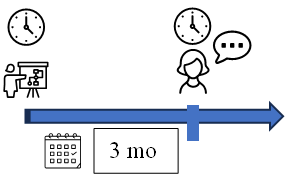Chapter 2: Time Travel
IV. Using the Perfect Continuous Tense for Time
1.0 Comparison with the Regular Perfect Tense
1.1 Similarities
Both the Perfect and Perfect Continuous Tenses are used to talk about how long something happens. Or it can tell when a current action began. The Perfect Tense connects the starting time of an action to a later time of the action.
1.2 Differences
With the ordinary Perfect Tense, the time of the action stops at the time of speaking, or we are speaking only of the time when the action started until the time of speaking.
Examples
I have eaten my vegetables.
I have arrived at the airport.
1.3 Expect Action to Continue
With the Perfect Continuous Tense, there is the expectation that the action will continue past the current time of the action. Just like the ordinary continuous tense, the action can happen around a point in time. In this case, however, although there is usually an expectation that the action will continue, it might not continue.
Examples
I had been living in Baja, Mexico, for three years when I moved into my new apartment (but I continued to live in Baja).
I have been studying for three hours (but I am not finished yet).
By next year, I will have been working at the factory for five years. I plan to continue working there.
2.0 The Perfect Continuous Tenses Connects Two Points of Time, Actions or Situations
- Like with the Perfect Tense, in the Perfect Continuous Tense the action happens at a starting point and an ending point or it can happen between a starting point and a later time. However, the action is usually expected to continue past the time of speaking or later time that is indicated.
Examples

I have been working on this project for three months (it is not finished yet).

I have been going to San Francisco regularly in the past year. That is where our head office is. I go there almost every month.
- The Perfect Continuous Tense is used to identify how long an action has taken place. It is also used to identify the starting point of an action that ends or is reported later. However, the action is expected to continue.

- We use ‘since’ to talk about when the action started.
- We use ‘for’ to talk about how long the action has been happening.
- In some cases, the action may have occurred forever into the past—or at least until the time that we were born. In this case, we use the time words ‘always’ or ‘never’.
Examples
I have been living in Chicago since 1995. (I have no plans to move)
At this point, I have been living in San Francisco for only three months. (it is implied that this will increase with time)
The moon has been going around the earth forever. (we don’t expect it to quit)
- Like the Perfect Tense, the Perfect Continuous Tense can include everything that happened in between the two points of time or action.
- This could be a single continuous action, a series of repeated actions, or a changing situation over time.
Examples
3.0 Non-Action Verbs
Like with the Continuous Tense, we don’t use the Perfect Progressive for verbs that are non-action (used to describe something) because action in the continuous tense is for a limited time.
Non-action verbs are used for descriptions of something or a situation, things that are relatively permanent.
4.0 Adverbs of Frequency
Adverbs of frequency are not used with the Continuous or the Perfect Continuous because the action is mostly continuous for the stated time.
However, sometimes ‘always’ and ‘never’ are used with the Continuous Tense or the Perfect Continuous Tense to express that something is excessive. This is often associated with negative emotions. Still, the Perfect Continuous Tense is rarely used with even ‘always’ or ‘never’. When used, it is used to show that this annoying continuous behavior is somewhat unusual for the person and is not expected to continue.
Examples
She is always complaining.
She has always been complaining. (temporary)
He is never studying.
He has never been studying. (temporary)

